Wildland and Forest Fire Emissions on Federally Managed Land in the United States, 2001–2021
Abstract
1. Introduction
2. Methods
2.1. Wildland Fires
2.2. Burned Area and Emissions Estimates
2.3. Allocation to Land Ownership
2.4. Allocation to Forest Versus Non-Forest
3. Results
3.1. Annual Wildland and Forest Fires
3.2. Emissions on Land Managed by Federal Agencies
4. Discussion
4.1. Allocation of Area Burned and Emissions
4.2. Implications
4.3. Limitations
4.4. Future Research Opportunities
5. Conclusions
Supplementary Materials
Author Contributions
Funding
Data Availability Statement
Acknowledgments
Conflicts of Interest
References
- Cattau, M.E.; Wessman, C.; Mahood, A.; Balch, J.K. Anthropogenic and lightning-started fires are becoming larger and more frequent over a longer season length in the U.S.A. Glob. Ecol. Biogeogr. 2020, 29, 668–681. [Google Scholar] [CrossRef]
- Dennison, P.E.; Brewer, S.C.; Arnold, J.D.; Moritz, M.A. Large wildfire trends in the western United States, 1984–2011. Geophys. Res. Lett. 2014, 41, 2928–2933. [Google Scholar] [CrossRef]
- Yang, J.; Tian, H.; Tao, B.; Ren, W.; Pan, S.; Liu, Y.; Wang, Y. A growing importance of large fires in conterminous United States during 1984–2012. J. Geophys. Res. Biogeosci. 2015, 120, 2625–2640. [Google Scholar] [CrossRef]
- Stevens-Rumann, C.S.; Morgan, P. Tree regeneration following wildfires in the western US: A review. Fire Ecol. 2019, 15, 15. [Google Scholar] [CrossRef]
- Jaffe, D.A.; O’Neill, S.M.; Larkin, N.K.; Holder, A.L.; Peterson, D.L.; Halofsky, J.E.; Rappold, A.G. Wildfire and prescribed burning impacts on air quality in the United States. J. Air Waste Manag. Assoc. 2020, 70, 583–615. [Google Scholar] [CrossRef] [PubMed]
- Agbeshie, A.A.; Abugre, S.; Atta-Darkwa, T.; Awuah, R. A review of the effects of forest fire on soil properties. J. For. Res. 2022, 33, 1419–1441. [Google Scholar] [CrossRef]
- Smith, H.G.; Sheridan, G.J.; Lane, P.N.J.; Nyman, P.; Haydon, S. Wildfire effects on water quality in forest catchments: A review with implications for water supply. J. Hydrol. 2011, 396, 170–192. [Google Scholar] [CrossRef]
- Hurteau, M.D.; Koch, G.W.; Hungate, B.A. Carbon protection and fire risk reduction: Toward a full accounting of forest carbon offsets. Front. Ecol. Env. 2008, 6, 493–498. [Google Scholar] [CrossRef]
- Oswalt, S.N.; Smith, W.B.; Miles, P.D.; Pugh, S.A. Forest Resources of the United States, 2017: A Technical Document Supporting the Forest Service 2020 RPA Assessment; Gen. Tech. Rep. WO-97; U.S. Department of Agriculture, Forest Service, Washington Office: Washington, DC, USA, 2020. [CrossRef]
- Giglio, L.; Boschetti, L.; Roy, D.P.; Humber, M.L.; Justice, C.L. The Collection 6 MODIS burned area mapping algorithm and product. Remote Sens. Environ. 2018, 217, 72–85. [Google Scholar] [CrossRef] [PubMed]
- Monitoring Trend in Burn Severity (MTBS). Website and Data. 2024. Available online: https://www.mtbs.gov/ (accessed on 15 August 2024).
- National Interagency Fire Center (NIFC). Fire Information. 2024. Available online: https://www.nifc.gov/fire-information/statistics (accessed on 10 April 2024).
- US EPA. Inventory of U.S. Greenhouse Gas Emissions and Sinks: 1990–2022; EPA 430R-24004; U.S. Environmental Protection Agency: Washington, DC, USA, 2024. Available online: https://www.epa.gov/ghgemissions/inventory-us-greenhouse-gas-emissions-and-sinks-1990-2022 (accessed on 22 October 2024).
- Weber, K.T.; Yadav, R. Spatiotemporal trends in wildfires across the western United States (1950–2019). Remote Sens. 2020, 12, 2959. [Google Scholar] [CrossRef]
- Merrill, M.D.; Sleeter, B.M.; Freeman, P.A. Federal Lands Greenhouse Gas Emissions and Sequestration in the United States—Estimates for 2005–22; U.S. Geological Survey Scientific Investigations Report 2024–5103, [Supersedes USGS Scientific Investigations Report 2018–5131]; U.S. Geological Survey: Reston, VA, USA, 2024. [CrossRef]
- Crist, M.R. Rethinking the focus on forest fires in federal wildland fire management: Landscape patterns and trends of non-forest and forest burned area. J. Environ. Manage. 2023, 327, 116718. [Google Scholar] [CrossRef] [PubMed]
- Congressional Budget Office. Wildfires, CBO Report. 2022. Available online: www.cbo.gov/publication/57970 (accessed on 13 November 2024).
- Congressional Research Service. Wildfire Statistics, CRS Report IF10244. 2023. Available online: https://crsreports.congress.gov/product/pdf/IF/IF10244/69 (accessed on 13 November 2024).
- Hawbaker, T.J.; Vanderhoof, M.K.; Schmidt, G.L.; Beal, Y.-J.; Picotte, J.J.; Takacs, J.D.; Falgout, J.T.; Dwyer, J.L. The Landsat Burned Area algorithm and products for the conterminous United States. Remote. Sens. Environ. 2020, 244, 111801. [Google Scholar] [CrossRef]
- Xu, Q.; Westerling, A.L.; Notohamiprodjo, A.; Wiedinmyer, C.; Picotte, J.J.; Parks, S.A.; Hurteau, M.D.; Marlier, M.E.; Kolden, C.A.; Sam, J.A.; et al. Wildfire burn severity and emissions inventory: An example implementation over California. Environ. Res. Lett. 2022, 17, 085008. [Google Scholar] [CrossRef]
- French, N.H.F.; Hudak, A.T. Biomass burning fuel consumption and emissions for air quality. In Landscape Fire, Smoke and Health: Linking Biomass Burning Emissions to Human Well-Being; Loboda, T.V., French, N.H.F., Puett, R.C., Eds.; Wylie-AGU: Washington, DC, USA, 2023; ISBN 978-1-119-75700-9. [Google Scholar]
- French, N.H.F.; McKenzie, D.; Erickson, T.; Koziol, B.; Billmire, M.; Endsley, K.A.; Scheinerman, N.K.Y.; Jenkins, L.; Miller, M.E.; Ottmar, R.; et al. Modeling Regional-Scale Wildland Fire Emissions with the Wildland Fire Emissions Information System*. Earth Interact. 2014, 18, 1–26. [Google Scholar] [CrossRef]
- French, N.H.F.; McKenzie, D.; Erickson, T.; Koziol, B.; Billmire, M.; Endsley, K.A.; Scheinerman, N.K.Y.; Jenkins, L.K.; Miller, M.E.; Ottmar, R.; et al. Annual Wildland Fire Emissions (WFEIS v0.5) for Conterminous US and Alaska, 2001–2013; ORNL DAAC: Oak Ridge, TN, USA, 2016. [Google Scholar] [CrossRef]
- Wiedinmyer, C.; Quayle, B.; Geron, C.; Belote, A.; McKenzie, D.; Zhang, X.; O’nEill, S.; Wynne, K.K. Estimating emissions from fires in North America for air quality modeling. Atmos. Environ. 2006, 40, 3419–3432. [Google Scholar] [CrossRef]
- Wiedinmyer, C.; Neff, J.C. Estimates of CO2 from fires in the United States: Implications for carbon management. Carbon Balance Manag. 2007, 2, 10. [Google Scholar] [CrossRef] [PubMed]
- Urbanski, S.P.; Reeves, M.C.; Corley, R.E.; Silverstein, R.P.; Hao, W.M. Contiguous United States wildland fire emission estimates during 2003–2015. Earth Syst. Sci. Data 2018, 10, 2241–2274. [Google Scholar] [CrossRef]
- Eidenshink, J.; Schwind, B.; Brewer, K.; Zhu, Z.-L.; Quayle, B.; Howard, S. A Project for Monitoring Trends in Burn Severity. Fire Ecol. 2007, 3, 3–21. [Google Scholar] [CrossRef]
- Picotte, J.J.; Bhattarai, K.; Howard, D.; Lecker, J.; Epting, J.; Quayle, B.; Benson, N.; Nelson, K. Changes to the Monitoring Trends in Burn Severity program mapping production procedures and data products. Fire Ecol. 2020, 16, 16. [Google Scholar] [CrossRef]
- WFEIS. The Wildland Fire Emission Inventory System Calculator. 2025. Available online: https://wfeis.mtri.org/home (accessed on 11 June 2025).
- Prichard, S.J.; Ottmar, R.D.; Anderson, G.K. Consume 3.0 User’s Guide; USDA Forest Service: Seattle, WA, USA; Pacific Northwest Research Station: Seattle, WA, USA; Pacific Wildland Fire Sciences Laboratory: Seattle, WA, USA; Fire and Environmental Research Applications Team: Seattle, WA, USA, 2006; p. 234. Available online: https://www.frames.gov/catalog/1260 (accessed on 3 April 2024).
- SERA 2025. The Smoke Emissions Reference Application database (SERA). Available online: https://depts.washington.edu/nwfire/sera/ (accessed on 11 June 2025).
- Abatzoglou, J.T. Development of gridded surface meteorological data for ecological applications and modelling. Int. J. Climatol. 2013. [Google Scholar] [CrossRef]
- GridMet. Dataset of The Climatology Lab. 2025. Available online: https://www.climatologylab.org/gridmet.html (accessed on 11 June 2025).
- GFWED. Global Fire WEather Database (GFWED) of the National Aeronautics and Space Administration. 2025. Available online: https://data.giss.nasa.gov/impacts/gfwed/ (accessed on 11 June 2025).
- FWI. Canadian Forest Fire Weather Index (FWI) System. 2025. Available online: https://cwfis.cfs.nrcan.gc.ca/background/summary/fwi (accessed on 11 June 2025).
- Ottmar, R.D.; Sandberg, D.V.; Riccardi, C.L.; Prichard, S.J. An overview of the Fuel Characteristic Classification System—Quantifying, classifying, and creating fuelbeds for resource planning. Can. J. For. Res. 2007, 37, 2383–2393. [Google Scholar] [CrossRef]
- Prichard, S.J.; Kennedy, M.C.; Andreu, A.G.; Eagle, P.C.; French, N.H.; Billmire, M. Next-Generation Biomass Mapping for Regional Emissions and Carbon Inventories: Incorporating Uncertainty in Wildland Fuel Characterization. J. Geophys. Res. Biogeosci. 2019, 124, 3699–3716. [Google Scholar] [CrossRef]
- Smith, J.E.; Billmire, M.; French, N.H.F.; Domke, G.M. Application of the wildland fire emissions inventory system to estimate fire emissions on forest lands of the United States. Carbon Balance Manag. 2024, 19, 26. [Google Scholar] [CrossRef] [PubMed]
- U.S. Geological Survey (USGS) Gap Analysis Project (GAP) Protected Areas Database of the United States (PAD-US) 3.0: U.S. Geological Survey. Available online: https://www.sciencebase.gov/catalog/item/65294599d34e44db0e2ed7cf (accessed on 13 March 2024).
- Yang, L.; Jin, S.; Danielson, P.; Homer, C.; Gass, L.; Bender, S.M.; Case, A.; Costello, C.; Dewitz, J.; Fry, J.; et al. A new generation of the United States National Land Cover Database: Requirements, research priorities, design, and implementation strategies. ISPRS J. Photogramm. Remote Sens. 2018, 146, 108–123. [Google Scholar] [CrossRef]
- NLCD. National Land Cover Database (NLCD) Science Product Images Developed by the Multi-Resolution Land Characteristics (MRLC) Consortium. 2023. Available online: https://www.mrlc.gov/ (accessed on 10 June 2024).
- Short, K.C. Spatial Wildfire Occurrence Data for the United States, 1992–2020 [FPA_FOD_20221014], 6th ed.; Forest Service Research Data Archive: Fort Collins, CO, USA, 2022. Available online: https://www.fs.usda.gov/rds/archive/catalog/RDS-2013-0009.6 (accessed on 10 April 2024).
- Downing, W.M.; Dunn, C.J.; Thompson, M.P.; Caggiano, M.P.; Short, K.C. Human ignitions on private lands drive USFS cross-boundary wildfire transmission and community impacts in the western US. Sci. Rep. 2022, 12, 2624. [Google Scholar] [CrossRef] [PubMed]
- WFIGS 2024. The Wildland Fire Interagency Geospatial Service Interagency Fire Perimeters; National Interagency Fire Center: Boise, ID, USA, 2023. Available online: https://wfigs-nifc.hub.arcgis.com/pages/wfigs-fire-history (accessed on 10 April 2024).
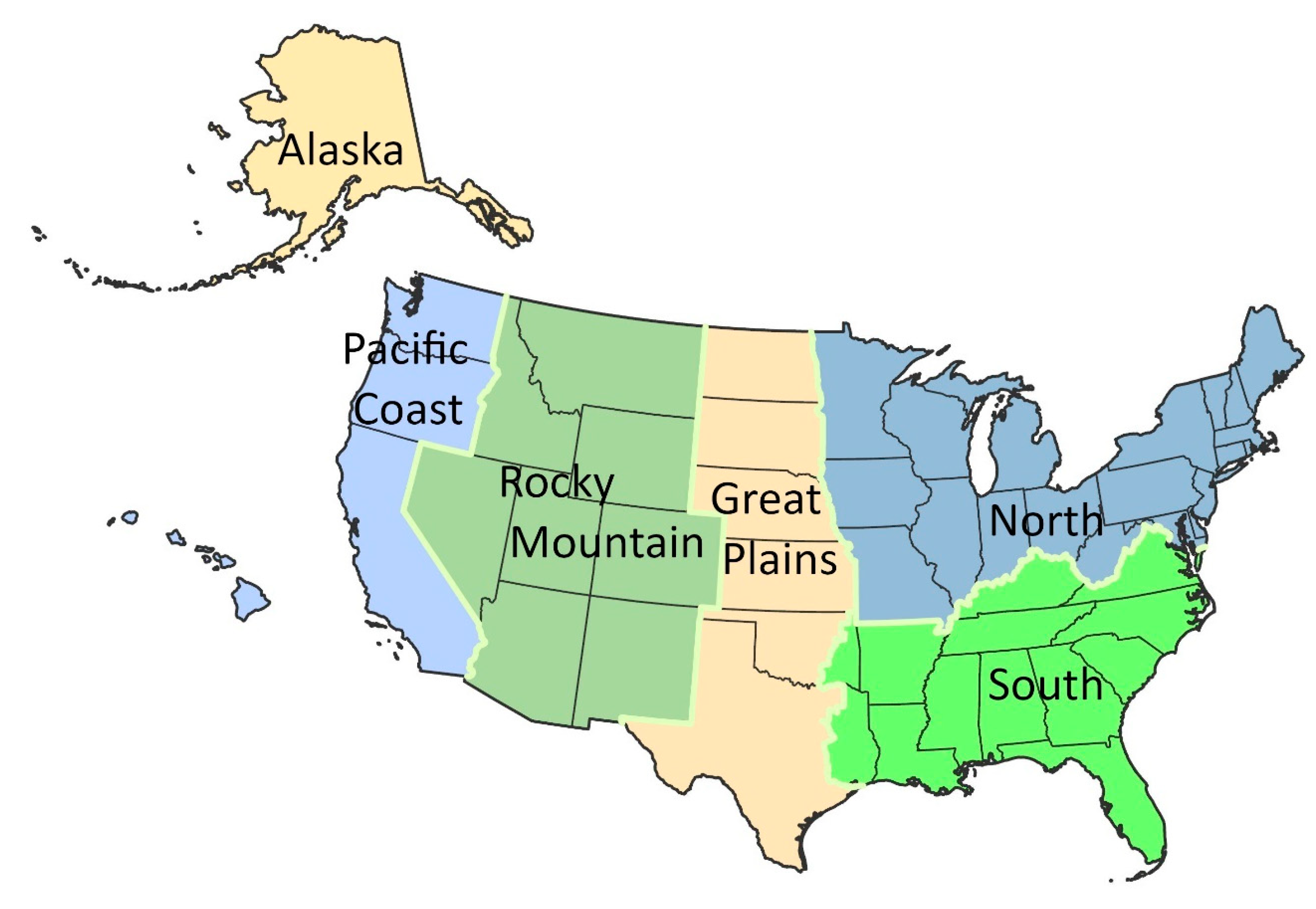
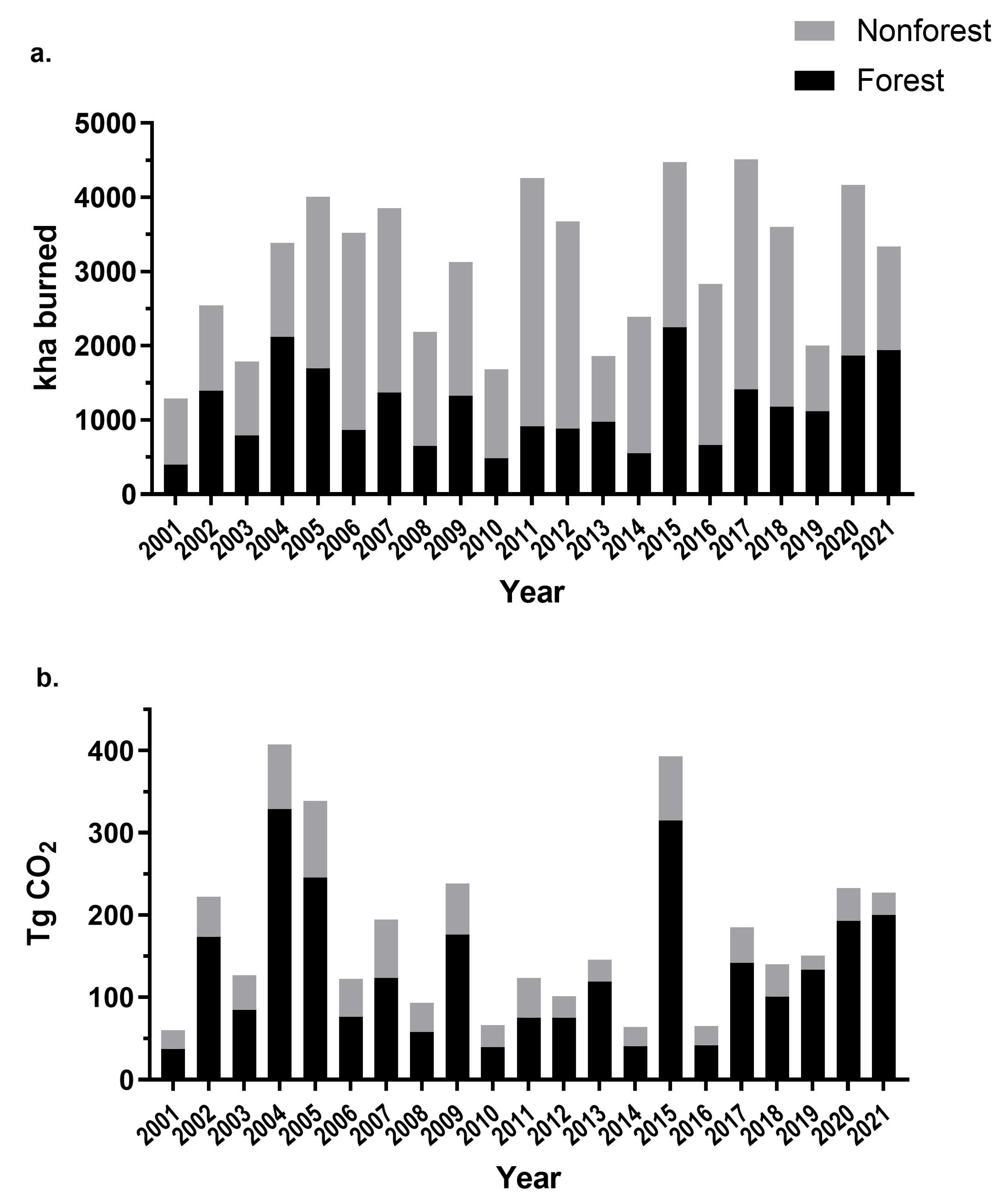
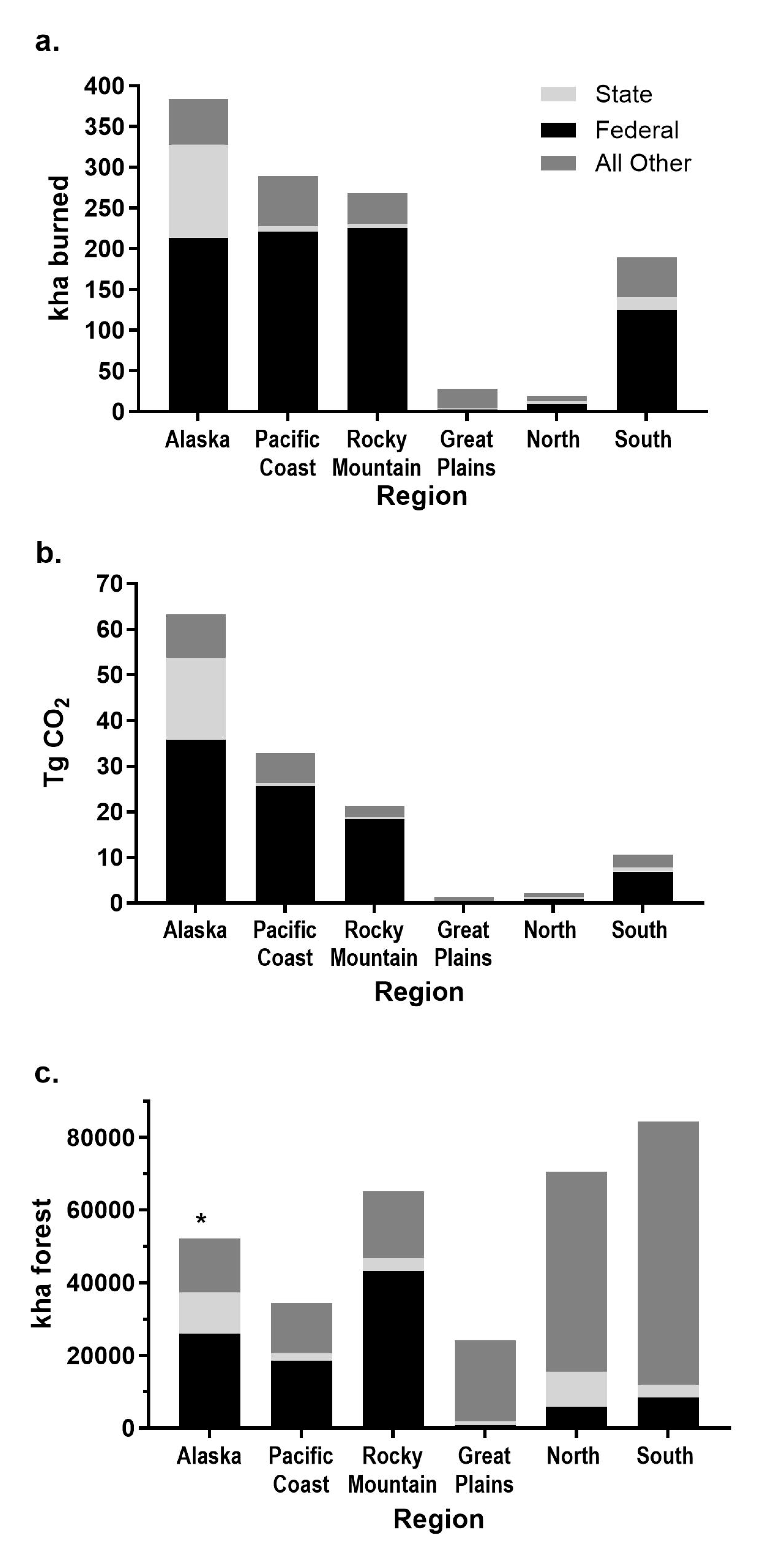
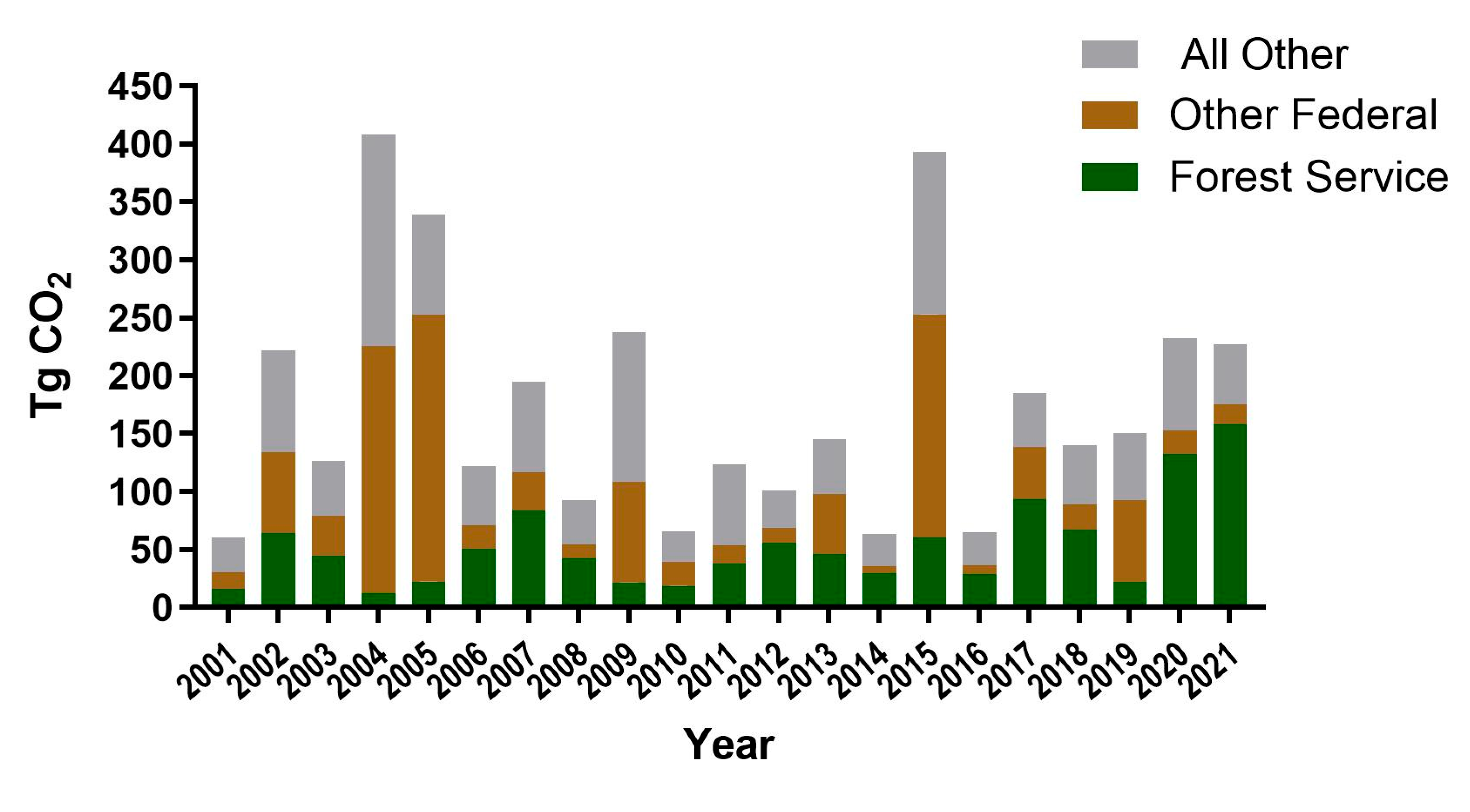
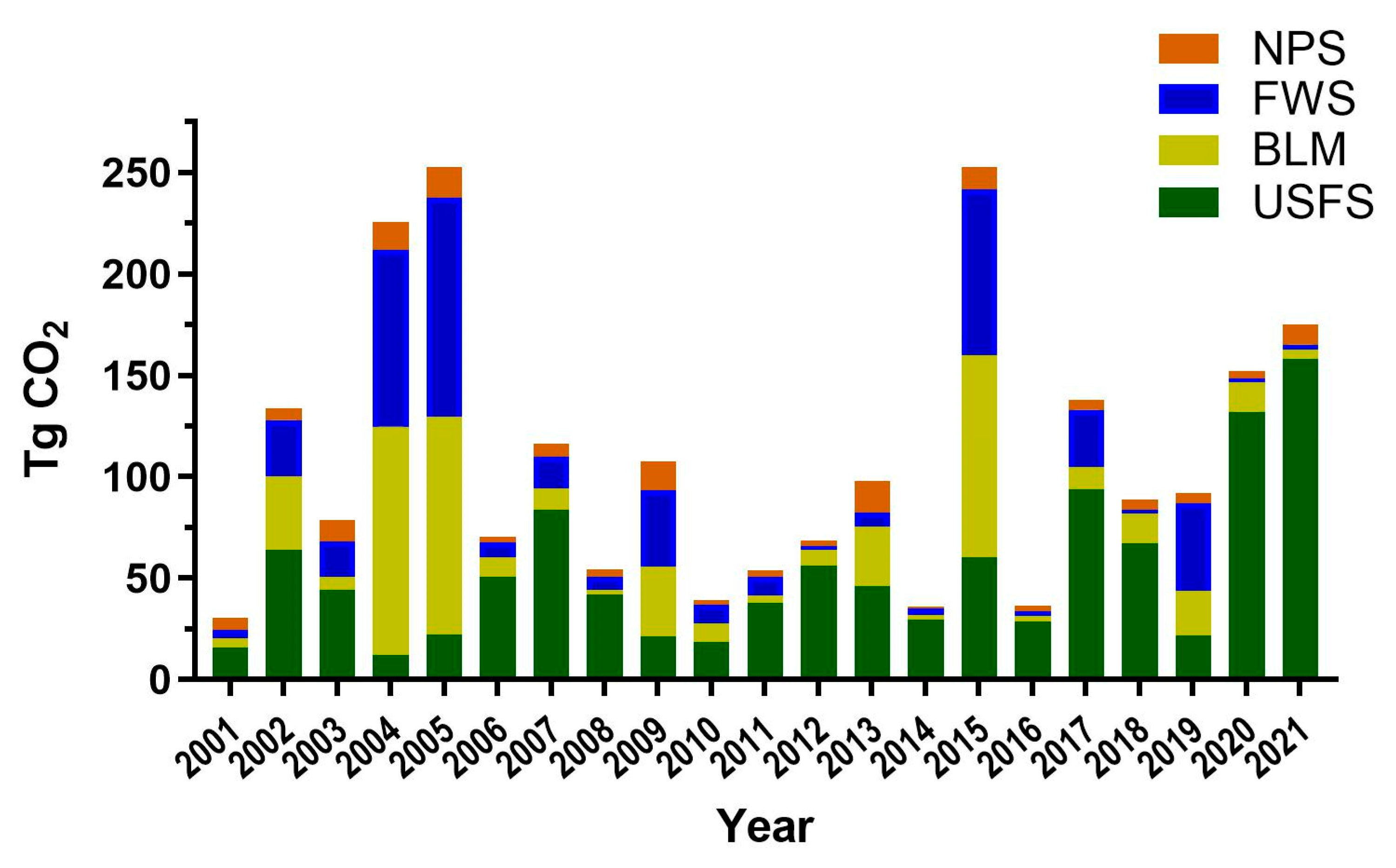
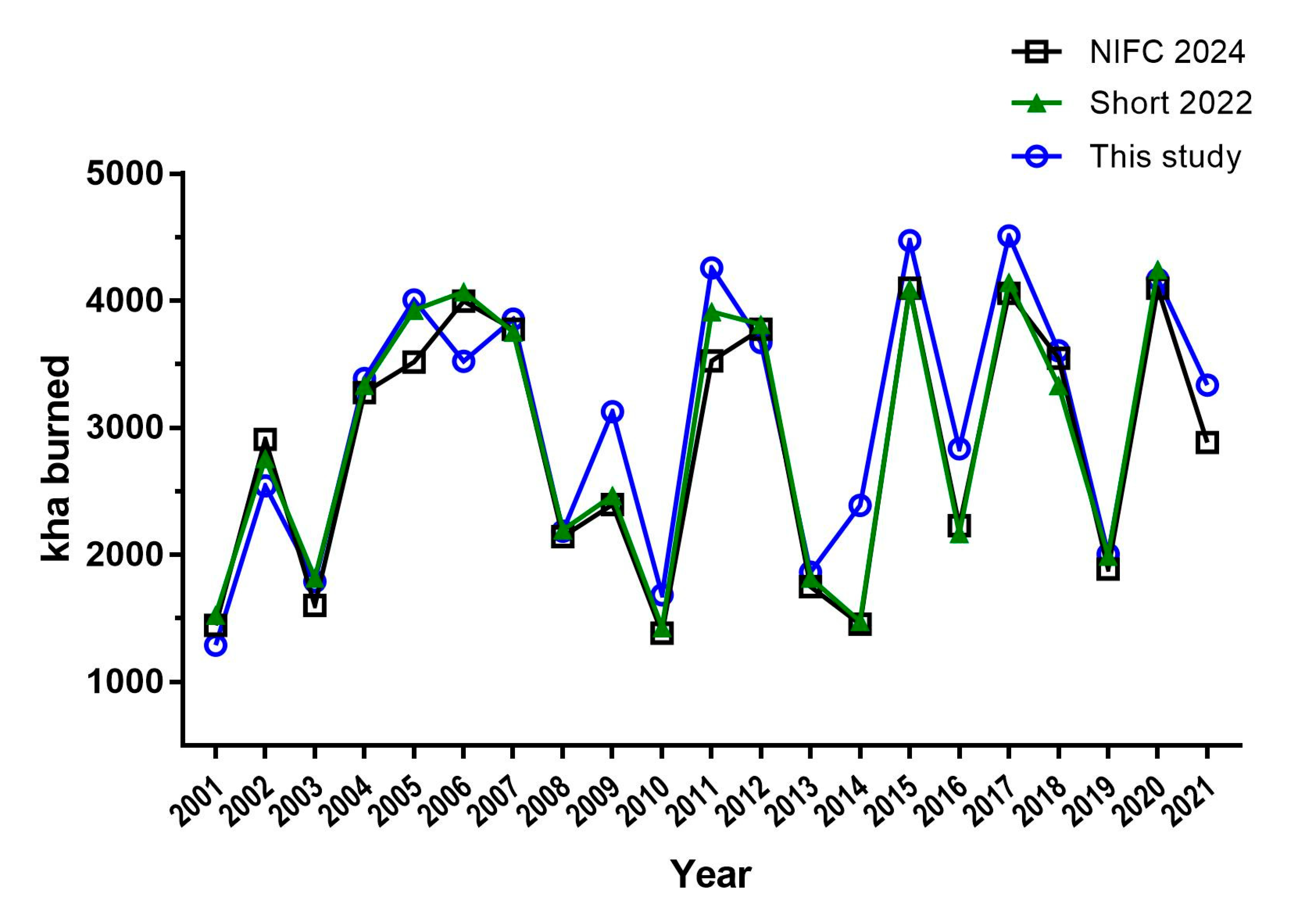
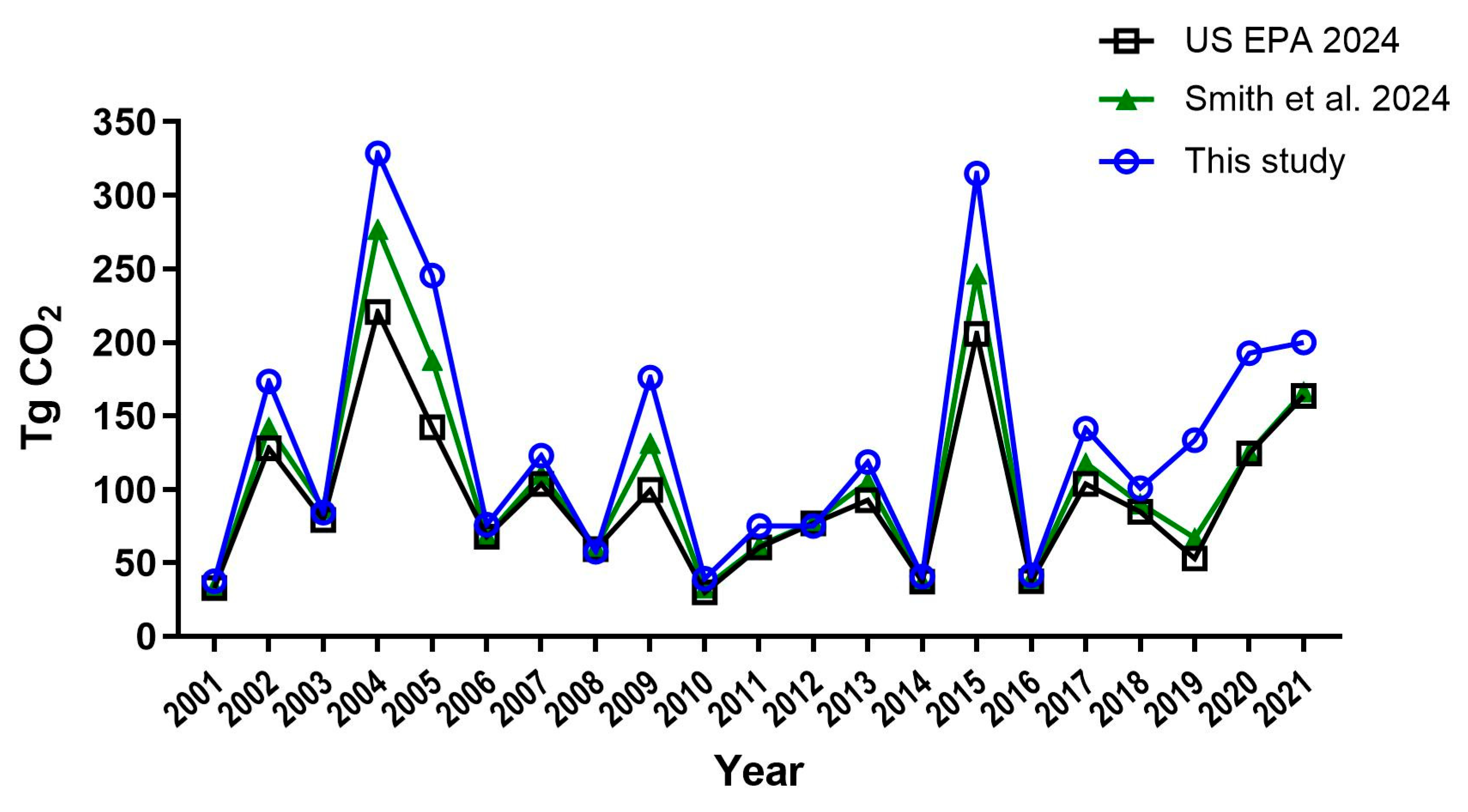
| Region | USFS | Other Federal | All Other | |||
|---|---|---|---|---|---|---|
| Forest | Non-forest | Forest | Non-forest | Forest | Non-forest | |
| Alaska | 0.06 | 0.13 | 213.14 | 125.29 | 170.44 | 81.26 |
| Pacific Coast | 200.31 | 99.49 | 20.80 | 96.36 | 68.12 | 207.11 |
| Rocky Mountain | 204.81 | 143.86 | 20.39 | 268.51 | 42.91 | 232.82 |
| Great Plains | 1.69 | 3.35 | 0.91 | 10.15 | 25.01 | 427.56 |
| North | 8.34 | 1.93 | 1.31 | 3.70 | 9.42 | 9.36 |
| South | 105.48 | 56.66 | 19.47 | 36.47 | 64.94 | 84.07 |
| All US | 520.68 | 305.43 | 276.02 | 540.48 | 380.84 | 1042.18 |
| Region | USFS | Other Federal | All Other | |||
|---|---|---|---|---|---|---|
| Forest | Non-forest | Forest | Non-forest | Forest | Non-forest | |
| Alaska | 0.01 | 0.00 | 35.83 | 8.47 | 27.40 | 4.81 |
| Pacific Coast | 23.11 | 2.55 | 2.49 | 1.07 | 7.24 | 3.36 |
| Rocky Mountain | 16.72 | 2.44 | 1.65 | 2.35 | 2.92 | 2.12 |
| Great Plains | 0.10 | 0.02 | 0.05 | 0.52 | 1.25 | 4.60 |
| North | 0.90 | 0.04 | 0.14 | 0.44 | 1.17 | 1.09 |
| South | 5.83 | 1.97 | 1.11 | 2.65 | 3.72 | 5.26 |
| All US | 46.67 | 7.02 | 41.26 | 15.51 | 43.71 | 21.24 |
| Region | USFS | FWS | BLM | NPS |
|---|---|---|---|---|
| Alaska | 0.19 | 160.21 | 154.92 | 23.30 |
| Pacific Coast | 299.79 | 2.43 | 95.19 | 18.15 |
| Rocky Mountain | 348.68 | 7.69 | 255.80 | 17.08 |
| Great Plains | 5.04 | 6.51 | 0.33 | 3.65 |
| North | 10.27 | 4.04 | - | 0.69 |
| South | 162.14 | 34.91 | 0.01 | 19.00 |
| All US | 826.11 | 215.80 | 506.25 | 81.86 |
| Region | USFS | FWS | BLM | NPS |
|---|---|---|---|---|
| Alaska | 0.02 | 20.33 | 21.03 | 3.01 |
| Pacific Coast | 25.03 | 0.09 | 2.15 | 1.38 |
| Rocky Mountain | 18.81 | 0.11 | 2.73 | 1.11 |
| Great Plains | 0.11 | 0.43 | 0.00 | 0.08 |
| North | 0.92 | 0.51 | - | 0.05 |
| South | 7.78 | 2.48 | 0.00 | 1.29 |
| All US | 52.67 | 23.95 | 25.92 | 6.93 |
Disclaimer/Publisher’s Note: The statements, opinions and data contained in all publications are solely those of the individual author(s) and contributor(s) and not of MDPI and/or the editor(s). MDPI and/or the editor(s) disclaim responsibility for any injury to people or property resulting from any ideas, methods, instructions or products referred to in the content. |
© 2025 by the authors. Licensee MDPI, Basel, Switzerland. This article is an open access article distributed under the terms and conditions of the Creative Commons Attribution (CC BY) license (https://creativecommons.org/licenses/by/4.0/).
Share and Cite
Hoover, C.M.; Smith, J.E. Wildland and Forest Fire Emissions on Federally Managed Land in the United States, 2001–2021. Forests 2025, 16, 1205. https://doi.org/10.3390/f16081205
Hoover CM, Smith JE. Wildland and Forest Fire Emissions on Federally Managed Land in the United States, 2001–2021. Forests. 2025; 16(8):1205. https://doi.org/10.3390/f16081205
Chicago/Turabian StyleHoover, Coeli M., and James E. Smith. 2025. "Wildland and Forest Fire Emissions on Federally Managed Land in the United States, 2001–2021" Forests 16, no. 8: 1205. https://doi.org/10.3390/f16081205
APA StyleHoover, C. M., & Smith, J. E. (2025). Wildland and Forest Fire Emissions on Federally Managed Land in the United States, 2001–2021. Forests, 16(8), 1205. https://doi.org/10.3390/f16081205







